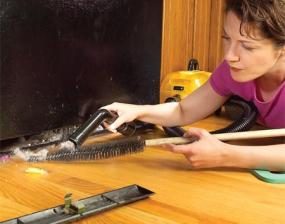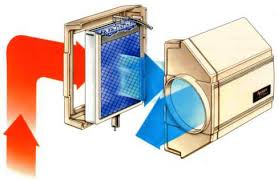November is a good month to move some
maintenance efforts indoors. This month also provides an opportunity to see if
your hard work during earlier months paid off — nothing tests waterproofing
efforts like a hard November rain.
Maintain large
appliances

As the holiday season begins, make sure your appliances are
prepared for the demands you will place on them. Pull your refrigerator from
the wall and clean the condenser coils in back with a vacuum cleaner with a
brush attachment. Also, vacuum dust from the front lower grille and clean the
drip pan and the drain leading to it (if your unit has one). Clean the oven and
stove drip pans on your electric range. Clean the surface burner on your gas
stove to ensure proper flame level. De-stench your in-sink garbage disposal by
packing it with ice cubes and 1/4 cup of baking soda; then turn it on. After
the ice-grinding noise stops, pour a kettle full of boiling water into the
sink. Check the dishwasher strainer and washer arm; clean if necessary.
Clean and maintain
closets
Go to your closets and perform these two simple tests: Can
you see floor space, and can you easily close the door? If the answer to either
one of these questions is no, clean your closet. Cramped closets can provide
haven for pests, too-full racks can break free from walls, and sliding doors
can be derailed by too much stuff. Add compartments and hanging racks at
different levels to utilize more space.
Maintain woodwork

November is a good month to repair and re-glue woodwork,
since indoor air is at its driest. If you are re-gluing wobbly dining room
chairs, clamp during drying by wrapping a rope tightly around the perimeter of
the legs. Be sure to protect wood surfaces with cardboard before tightening
rope. Try using toothpaste on white water stains on wood surfaces. Once the
stain is removed, polish with furniture polish. Use paste wax and elbow grease
to put a new sheen on wood furniture.
Clear leaves from
gutters
Cleaning gutters is a slimy job, but the task will protect
your siding and basement from expensive water damage. Don long rubber gloves,
grab a gallon bucket and scoop leaves into the bucket by hand. Trying to use a
garden trowel or other device just makes the task more cumbersome and can
damage gutters. Blast the scum from the bottom of the gutter with a hose
equipped with a pressure nozzle. If it doesn't drain well, feed your running
hose up the pipe to knock loose the clog. Dump the contents of the bucket on
your compost pile and pat yourself on the back for a dirty job well done.
Speaking of leaves
...

Check some other places where accumulated leaves can be a
problem. If leaves are piled in the valleys of your roof, they can retain water
and initiate leaks. Walk your property with a shovel and clear drainage ditches
and culverts of leaf buildup. Also, a moderate amount of leaves on a lawn can
provide a natural mulch, but if large amounts are left to soak up winter rains,
they will smother the grass beneath them.
Have problem trees
trimmed
Now that you've cleaned your gutters, you know which trees
are dumping leaves on your roof, shading it enough to encourage moss, and close
enough to cause serious damage should they lose a branch in a storm. Trees are
dormant this time of the year and can withstand extensive pruning. Decide which
ones need cutting back and hire a professional to do the job. This is not a
do-it-yourself task if the trees you are looking at are high enough to affect
your roof. Trimming large trees is a dangerous job that should be left to an
expert.
Maintain moisture

Heaters, especially forced air and wood stoves, can rob a
home of humidity. A touch of moisture in the air makes heated air feel warmer,
so you can keep the heat at a slightly lower temperature if your humidity is
balanced. If your woodwork is cracking or your skin seems excessively dry, you
need more moisture in your home. A furnace-mounted humidifier is likely the
answer if your home has central forced-air heat and other measures don't
moisten things up. If you have a wood stove, put a non-whistling teakettle on
it and add water regularly (check it daily to make sure the water hasn't
evaporated). If you prefer not to go by feel, buy an inexpensive instrument
called a hygrometer that measures humidity.
Check your sump pump
Some unfinished basements in wet areas have sump pumps
installed. These pumps switch on automatically when groundwater levels rise,
eliminating basement water before it becomes a problem. If you have one, make
sure it is in good working order before the rainy season starts.
No comments:
Post a Comment